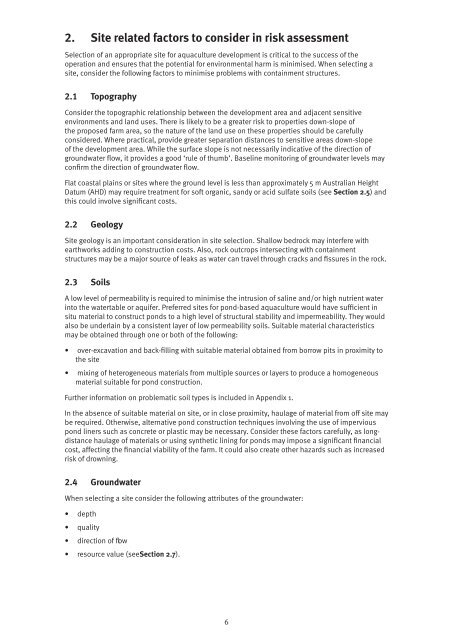Guidelines for constructing and maintaining aquaculture ...
Guidelines for constructing and maintaining aquaculture ...
Guidelines for constructing and maintaining aquaculture ...
You also want an ePaper? Increase the reach of your titles
YUMPU automatically turns print PDFs into web optimized ePapers that Google loves.
2. Site related factors to consider in risk assessment<br />
Selection of an appropriate site <strong>for</strong> <strong>aquaculture</strong> development is critical to the success of the<br />
operation <strong>and</strong> ensures that the potential <strong>for</strong> environmental harm is minimised. When selecting a<br />
site, consider the following factors to minimise problems with containment structures.<br />
2.1 Topography<br />
Consider the topographic relationship between the development area <strong>and</strong> adjacent sensitive<br />
environments <strong>and</strong> l<strong>and</strong> uses. There is likely to be a greater risk to properties down-slope of<br />
the proposed farm area, so the nature of the l<strong>and</strong> use on these properties should be carefully<br />
considered. Where practical, provide greater separation distances to sensitive areas down-slope<br />
of the development area. While the surface slope is not necessarily indicative of the direction of<br />
groundwater flow, it provides a good ‘rule of thumb’. Baseline monitoring of groundwater levels may<br />
confirm the direction of groundwater flow.<br />
Flat coastal plains or sites where the ground level is less than approximately 5 m Australian Height<br />
Datum (AHD) may require treatment <strong>for</strong> soft organic, s<strong>and</strong>y or acid sulfate soils (see Section 2.5) <strong>and</strong><br />
this could involve significant costs.<br />
2.2 Geology<br />
Site geology is an important consideration in site selection. Shallow bedrock may interfere with<br />
earthworks adding to construction costs. Also, rock outcrops intersecting with containment<br />
structures may be a major source of leaks as water can travel through cracks <strong>and</strong> fissures in the rock.<br />
2.3 Soils<br />
A low level of permeability is required to minimise the intrusion of saline <strong>and</strong>/or high nutrient water<br />
into the watertable or aquifer. Preferred sites <strong>for</strong> pond-based <strong>aquaculture</strong> would have sufficient in<br />
situ material to construct ponds to a high level of structural stability <strong>and</strong> impermeability. They would<br />
also be underlain by a consistent layer of low permeability soils. Suitable material characteristics<br />
may be obtained through one or both of the following:<br />
• over-excavation <strong>and</strong> back-filling with suitable material obtained from borrow pits in proximity to<br />
the site<br />
• mixing of heterogeneous materials from multiple sources or layers to produce a homogeneous<br />
material suitable <strong>for</strong> pond construction.<br />
Further in<strong>for</strong>mation on problematic soil types is included in Appendix 1.<br />
In the absence of suitable material on site, or in close proximity, haulage of material from off site may<br />
be required. Otherwise, alternative pond construction techniques involving the use of impervious<br />
pond liners such as concrete or plastic may be necessary. Consider these factors carefully, as longdistance<br />
haulage of materials or using synthetic lining <strong>for</strong> ponds may impose a significant financial<br />
cost, affecting the financial viability of the farm. It could also create other hazards such as increased<br />
risk of drowning.<br />
2.4 Groundwater<br />
When selecting a site consider the following attributes of the groundwater:<br />
• depth<br />
• quality<br />
• direction of flow<br />
• resource value (see Section 2.7).<br />
6

















